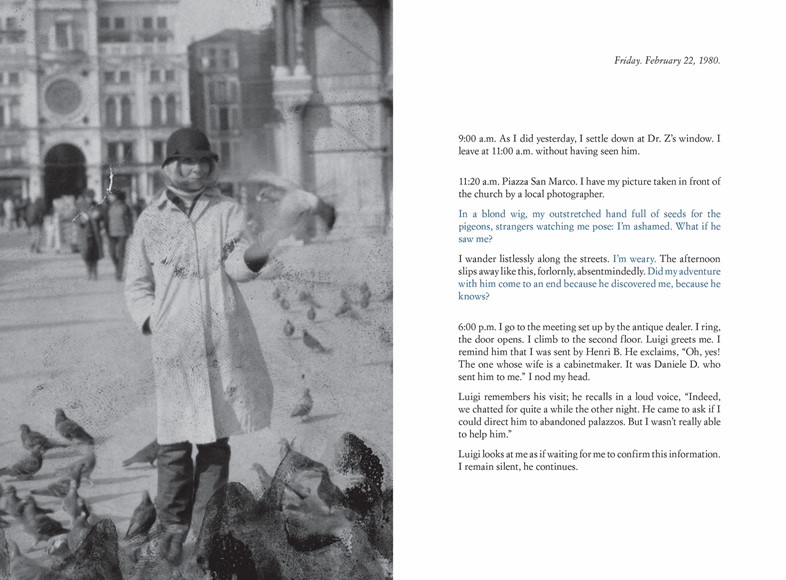For months I followed strangers on the street. For the pleasure of following them, not because they particularly interested me. I photographed them without their knowledge, took note of their movements, then finally lost sight of them and forgot them. At the end of January 1980, on the streets of Paris, I followed a man whom I lost sight of a few minutes later in the crowd. That very evening, quite by chance, he was introduced to me at an opening. During the course of our conversation, he told me he was planning an imminent trip to Venice. I decided to follow him.
(Calle and Baudrillard 1988, p.2.)
In 1979 Sophie Calle decided to leave the fate of her work into the hands of a stranger. Sophie Calle is a contemporary artist dipping into mediums such as writing, photography and installation art. Though her most well known series is, Suite Vénitienne, where she followed a man from Paris to Venice and documented him over his thirteen day stay in Venice.
Sophie Calle’s, Suite Vénitienne, was a ground breaking project in the world of contemporary art. It had been seen before that artists would use others to influence their own work, but Calle had managed to take it to the next level with this series. She had already taken to the practice of following strangers though one day she began following a man, referred to only as Henri B., in Paris without his knowledge; taking images and notes to document his whereabouts. ‘Henri B’ ended up being different from the other people that Calle had followed as she ended up being introduced to him at a party where she learns he is planning on going to Venice on a trip. In this moment Calle decides she will continue her research on Henri in Venice and track him down when she was there.
Calle had no clue where Henri would be staying or going in his trip so she called around hotels asking for him, tracking him down, and once she found him she would wait outside his hotel and follow him for days at a time. Occasionally Calle would purposely lose him and use the connections and friends she had made on this trip in the city to track him down again. Calle continued to shadow Henri from a distance until he returned back to Paris.

The work was initially produced as a book in 1983 and then in the same year made into a sound installation in a confessional booth . In 1996 Calle made the series into gallery-based work; purposefully making the series resemble that of a detective novel with inspiration from classic film noir. Calle used text to combine the images and story together and show the observations she made about Henri as well as the lengths she went to whilst out there. As the story progresses, Calle’s chronological entries incorporate detached and the tone shifts to resemble that of a diary. It is highlighted through the text her emotional state in this process by making the text italic when she expresses her subversive emotional subtext in the work. For instance, Calle describes a child playing in the Piazza San Marco as ‘I watch at length a little boy with a feathered headdress who’s tirelessly chasing pigeons with a knife. I would like to see him kill one.’ (Calle and Baudrillard 1988, p.20.)
All the images that are displayed with the text are all candids, suiting the detective film noir tone to the series as a gallery piece, that showed Henri’s movements and documented where he visited in the city. Henri was a keen amateur photographer and, while shadowing Henri, Calle also attempted to replicate the photographs he took. To remain undetected Calle used a ‘Squintar’ mirrored lens attachment, which allowed her to photograph subjects without aiming her camera directly at them. Calle also used a range of disguises to remain under the radar such as a variety of wigs, hats and props to hide behind like newspapers and books; echoing cliches of detective stories.

This series is an inspiration to contemporary art as it really pushes the boundaries of observation and control. It really is an inspiration to leave no control but let your subject take you to your art; to let them make your work and you just document it. This is a scary leap of faith as you don’t know where you could end up or what you may be doing. This is something I want to try and replicate, not to the same extent as being a uni student I don’t really have the funds to fly off to another country on a whim to follow some one … , to push the boundaries not only on my work but on my comfort zone too. This would help expand my horizon as an artist and to relinquish control in this day and age where we have total control over our work down to advanced settings on cameras and photoshop for editing till we achieve the result we want.
- Sophie Calle and Jean Baudrillard, Suite Vénitienne/Please Follow Me, trans. by Dany Barash and Danny Hatfield, Seattle 1988.
